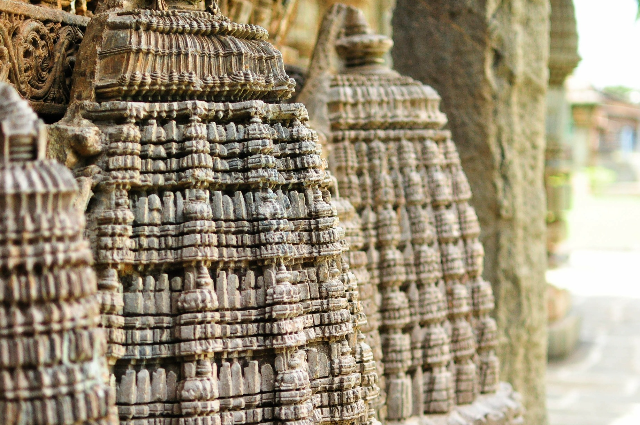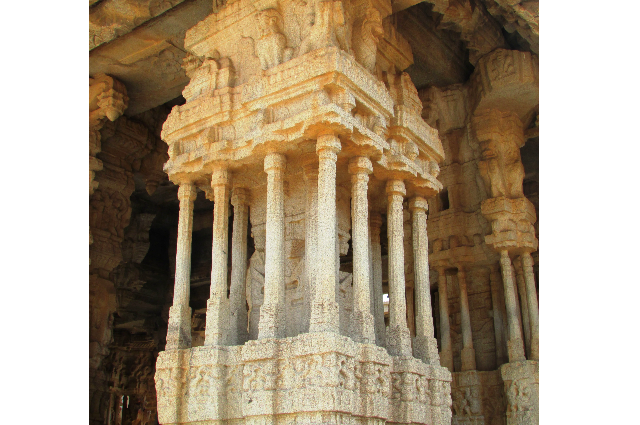INTRODUCTION

Source: Hoysala-sculpture from Pixabay
I am very excited to write my thoughts on this topic as this is very dearest to me. Indian sculpture and architecture dates back to 800BC and has a rich legacy of expounding some of the most intricate designs and engineering. Every sculpture and architecture produced is an embodiment of Indian traditions like the Vedas (The scripture), Shilpa Shastra( Science of Arts and Crafts), and Vastu Shastra (Science of building architecture). The beholder who confronts an Indian work of art, should not be ignorant of its traditions. If he is ignorant, then he will only see its form and the quality of work will only evoke a vague response to the total awareness that has gone into its making.
Let us now dive into the divinity in Indian sculpture and architecture.
Every sculpture and architecture created in India was on the following basis.
THE VEDAS

Source: Kailasa Temple ( Ellora caves) from Pixabay
The Vedas were composed between 1500 B.C. and 600 B.C. Vedas emphasize the methods of freedom and liberation of human life. Deities are just symbolic of the supreme principles that the Vedas uphold. Vedas provided the necessary verbal expressions for the Indian sculptures.
When the stupendous work of Kailashanatha temple at Ellora caves was completed, the sculptor exclaimed in wonder 'O how did I make it?' This form of question reaffirms the tradition that art is not rooted in the ego, but exists in the phase of consciousness.
Vastu Shastra

Source : Ajanta Caves from Pixabay
The science of architecture was called Vastu Shastra. Our sages and saints developed Vastu science after a great deal of research and experimentation. These are a series of texts describing the principles of design, layout, measurements, ground preparation, spatial geometry, and space arrangement. Where we live can influence our happiness, wealth, health, and prosperity.
Ajanta caves are some of the finest examples of Indian Vastu Shastra. There are twenty-nine caves in Ajanta comprising of intricate carvings, roofs, pillars, stupas, assembly halls, etc.
Shilpa Shastra

Source : Pixabay
Shilpa Shastra is known as the science of sculpture. It spoke a lot about the proportions, principles, composition as well as meanings of architecture. They also include chapters on paintings, both miniature and large. Sanskrit texts such as Shilparatna and Manasara describe the process and principles for artwork with metals, particularly for alloys such as panchadhatu (five metals – zinc, tin, copper, silver, and gold) and ashtadhatu (eight metal alloys – which adds iron, lead, and mercury to panchadhatu).
Unique Sculptures and architectures of India
Now let us look into some of the architectural marvels of Indian art.
1) Musical Pillars

Source : Vijaya Vittala temple ( Hampi) from Pixabay
Located in Karnataka, the pillars at the Vijaya Vittala temple resonate with music when struck. They are a group of stone shafts that produce musical notes of varying frequencies when tapped.
These pillars are of two types:
1) Beating/Tapping pillars
2) Blowing pillars.
First type produces sound when tapped, and the second type, which is most likely hollow, works like a wind instrument. The first type of pillars are further classified into three categories: Shruti, Gana and Laya. It is suggested that shruti produces swaras, gana produces classical ragas, and laya produces taal.
2) Iron Pillar

Source : Iron Pillar from Pixabay
The Iron pillar of Delhi is a real marvel with dimensions of 23 feet 8 inches (7.21 metres) height with a 16-inch (41 cm) diameter that was constructed by Chandragupta II in 375–415 CE. It now stands in the Qutb complex at Mehrauli in Delhi. It is famous for the rust-resistant composition of the metals used in its construction. There is also empirical evidence of high purity metallurgy and artworks. It contains 99.72% iron without showing any signs of rust, is empirical evidence of the state of metallurgical arts in 5th century India.
3) Konark Sun Temple

Source : Konark Sun Temple from Pixabay
Konark sun temple is a 13th century temple located in Odisha. Have you wondered how ancient people keep track of time, days, years? We might have heard of sun-dials and moon-dials. These dials were so precise that they gave time to the accuracy of the very minute. One such dial at the Konark temple in Odisha, where 24 intricately carved wheels tell a story. From a distance, they resemble another wonder of India's architecture prowess and in close up, they have spokes and beads that have been mathematically and meticulously placed to reveal the time of the day. Even the carvings depict stories of season of the year along with the time of the day.
4) Hanging Pillar

Source : The Hanging Pillar of Lepakshi Temple from Pixabay
The beautiful 16th century Veerabhadra temple, also known as Lepakshi temple, is located in the small historical village of Lepakshi in the Anantapur District of Andhra Pradesh. Built in the typical style of Vijayanagara architecture, the temple features many exquisite sculptures of god, goddesses, dancers and musicians, and hundreds of paintings all over the walls, columns and ceiling depicting stories from the epics of the Mahabharata, the Ramayana, and the Puranas. Here stone pillar is hanging from the ceiling.
Conclusion
Indian art of sculpture and architecture boasted a marvelous engineering and artisanry capabilities. This is the kind of growth our country had in the past and something we all must take inspirations from.
